A Comprehensive Analysis of Marketing Communication Tools for SMEs
VerifiedAdded on 2023/04/21
|12
|3715
|260
Essay
AI Summary
This essay examines various marketing communication tools employed by small businesses, emphasizing the importance of networking, proactive word-of-mouth marketing, personal selling, advertising, and internet-based strategies. It highlights how SMEs can leverage these tools, including websites and viral advertising, to enhance customer engagement and build brand awareness. The role of intermediaries and the structure of marketing communication plans are also discussed, noting the importance of market analysis, customer segmentation, and setting measurable communication objectives. The essay underscores the need for SMEs to adapt their communication strategies to market conditions to achieve profitability and manage risks effectively. Desklib offers a platform to explore similar solved assignments and past papers for students seeking academic support.
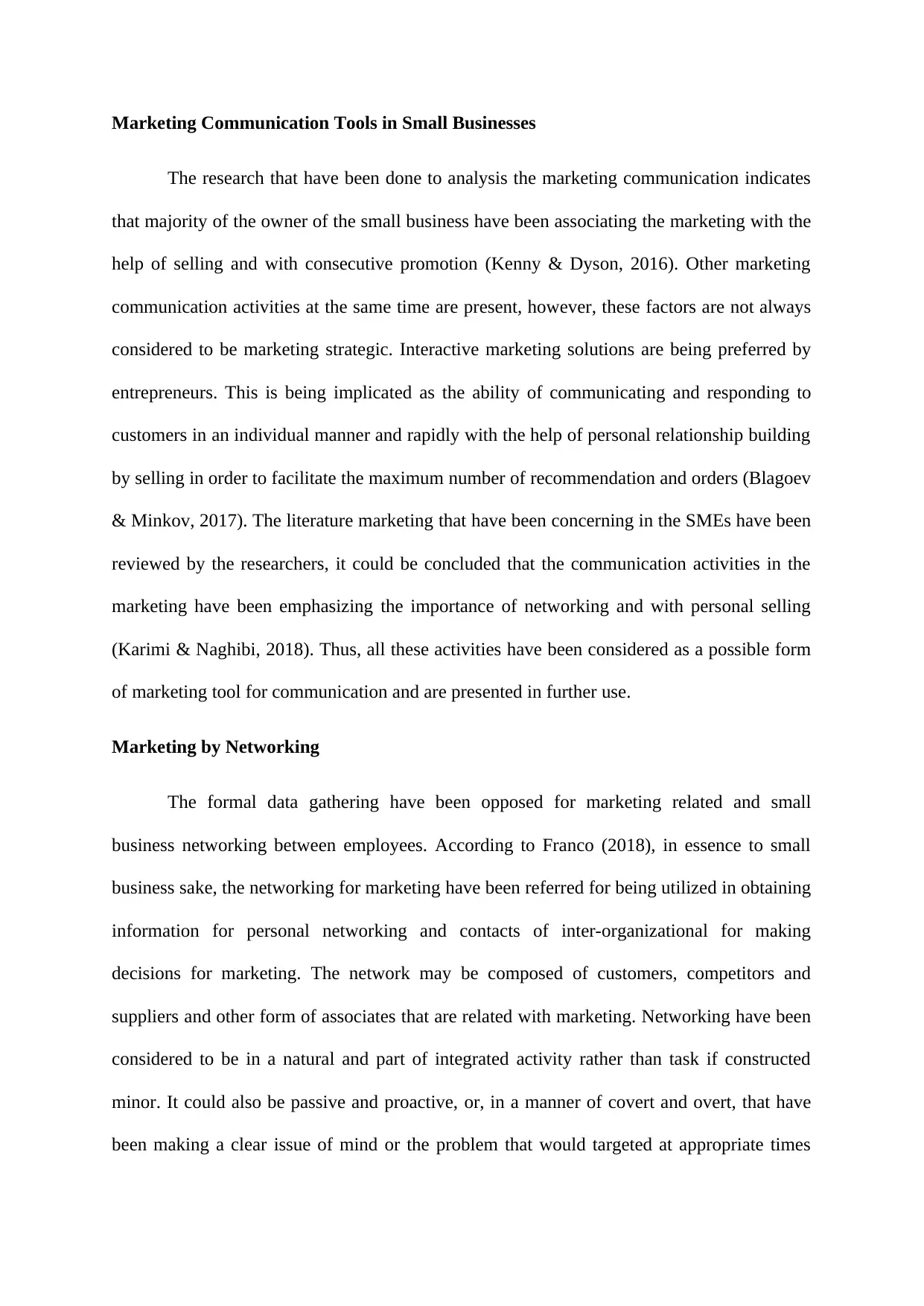
Marketing Communication Tools in Small Businesses
The research that have been done to analysis the marketing communication indicates
that majority of the owner of the small business have been associating the marketing with the
help of selling and with consecutive promotion (Kenny & Dyson, 2016). Other marketing
communication activities at the same time are present, however, these factors are not always
considered to be marketing strategic. Interactive marketing solutions are being preferred by
entrepreneurs. This is being implicated as the ability of communicating and responding to
customers in an individual manner and rapidly with the help of personal relationship building
by selling in order to facilitate the maximum number of recommendation and orders (Blagoev
& Minkov, 2017). The literature marketing that have been concerning in the SMEs have been
reviewed by the researchers, it could be concluded that the communication activities in the
marketing have been emphasizing the importance of networking and with personal selling
(Karimi & Naghibi, 2018). Thus, all these activities have been considered as a possible form
of marketing tool for communication and are presented in further use.
Marketing by Networking
The formal data gathering have been opposed for marketing related and small
business networking between employees. According to Franco (2018), in essence to small
business sake, the networking for marketing have been referred for being utilized in obtaining
information for personal networking and contacts of inter-organizational for making
decisions for marketing. The network may be composed of customers, competitors and
suppliers and other form of associates that are related with marketing. Networking have been
considered to be in a natural and part of integrated activity rather than task if constructed
minor. It could also be passive and proactive, or, in a manner of covert and overt, that have
been making a clear issue of mind or the problem that would targeted at appropriate times
The research that have been done to analysis the marketing communication indicates
that majority of the owner of the small business have been associating the marketing with the
help of selling and with consecutive promotion (Kenny & Dyson, 2016). Other marketing
communication activities at the same time are present, however, these factors are not always
considered to be marketing strategic. Interactive marketing solutions are being preferred by
entrepreneurs. This is being implicated as the ability of communicating and responding to
customers in an individual manner and rapidly with the help of personal relationship building
by selling in order to facilitate the maximum number of recommendation and orders (Blagoev
& Minkov, 2017). The literature marketing that have been concerning in the SMEs have been
reviewed by the researchers, it could be concluded that the communication activities in the
marketing have been emphasizing the importance of networking and with personal selling
(Karimi & Naghibi, 2018). Thus, all these activities have been considered as a possible form
of marketing tool for communication and are presented in further use.
Marketing by Networking
The formal data gathering have been opposed for marketing related and small
business networking between employees. According to Franco (2018), in essence to small
business sake, the networking for marketing have been referred for being utilized in obtaining
information for personal networking and contacts of inter-organizational for making
decisions for marketing. The network may be composed of customers, competitors and
suppliers and other form of associates that are related with marketing. Networking have been
considered to be in a natural and part of integrated activity rather than task if constructed
minor. It could also be passive and proactive, or, in a manner of covert and overt, that have
been making a clear issue of mind or the problem that would targeted at appropriate times
Paraphrase This Document
Need a fresh take? Get an instant paraphrase of this document with our AI Paraphraser

(Finne & Grönroos, 2017). The activity have been doubtful over the grounds that networking
can be decisive, however, it could be contributed on the decision made finally. On the other
hand, the network that have been made for the entrepreneurs does not have any kind of
standard mechanism and there are many rare cases where specific objective are seen. All the
discussion form the above have been suggesting that the communication that have been
related to the activities of networking of SME have been alternative to the formal marketing
research as the fact that networking many be revealing the vital information about the needs
and the prospects, all the effectiveness of the channels and the events that could be used for
building relationship (Odoom, Anning-Dorson, & Acheampong, 2017). On this respect, it
could be concluded that the worthy could be identified as to be the key establishment in
developing the networking and gaining the information.
Proactive approach to word-of-mouth marketing
The process was established on the fact that the referrals are to be preferred way for
the majority of the owner manager of the SME. The definition of the proactive approach to
word-to-mouth marketing is demonstrated as the recommendation that is mostly written or
oral that is satisfied by the customer on the prospective of the customers of better services
and services. With the consideration to be one of the most effective way for making
promotion, it is somewhat known as word-to-mouth advertising (Ratten, 2016). However on
a practical manner, it could also be classified as the product of the marketing communication.
Moreover, reliance on recommendations suits to the resources of small businesses. At the
same time new firms need to build a customer base first and firms who intend to reach new
target markets figure out how to reach customers who are not within an existing referral
network.
can be decisive, however, it could be contributed on the decision made finally. On the other
hand, the network that have been made for the entrepreneurs does not have any kind of
standard mechanism and there are many rare cases where specific objective are seen. All the
discussion form the above have been suggesting that the communication that have been
related to the activities of networking of SME have been alternative to the formal marketing
research as the fact that networking many be revealing the vital information about the needs
and the prospects, all the effectiveness of the channels and the events that could be used for
building relationship (Odoom, Anning-Dorson, & Acheampong, 2017). On this respect, it
could be concluded that the worthy could be identified as to be the key establishment in
developing the networking and gaining the information.
Proactive approach to word-of-mouth marketing
The process was established on the fact that the referrals are to be preferred way for
the majority of the owner manager of the SME. The definition of the proactive approach to
word-to-mouth marketing is demonstrated as the recommendation that is mostly written or
oral that is satisfied by the customer on the prospective of the customers of better services
and services. With the consideration to be one of the most effective way for making
promotion, it is somewhat known as word-to-mouth advertising (Ratten, 2016). However on
a practical manner, it could also be classified as the product of the marketing communication.
Moreover, reliance on recommendations suits to the resources of small businesses. At the
same time new firms need to build a customer base first and firms who intend to reach new
target markets figure out how to reach customers who are not within an existing referral
network.
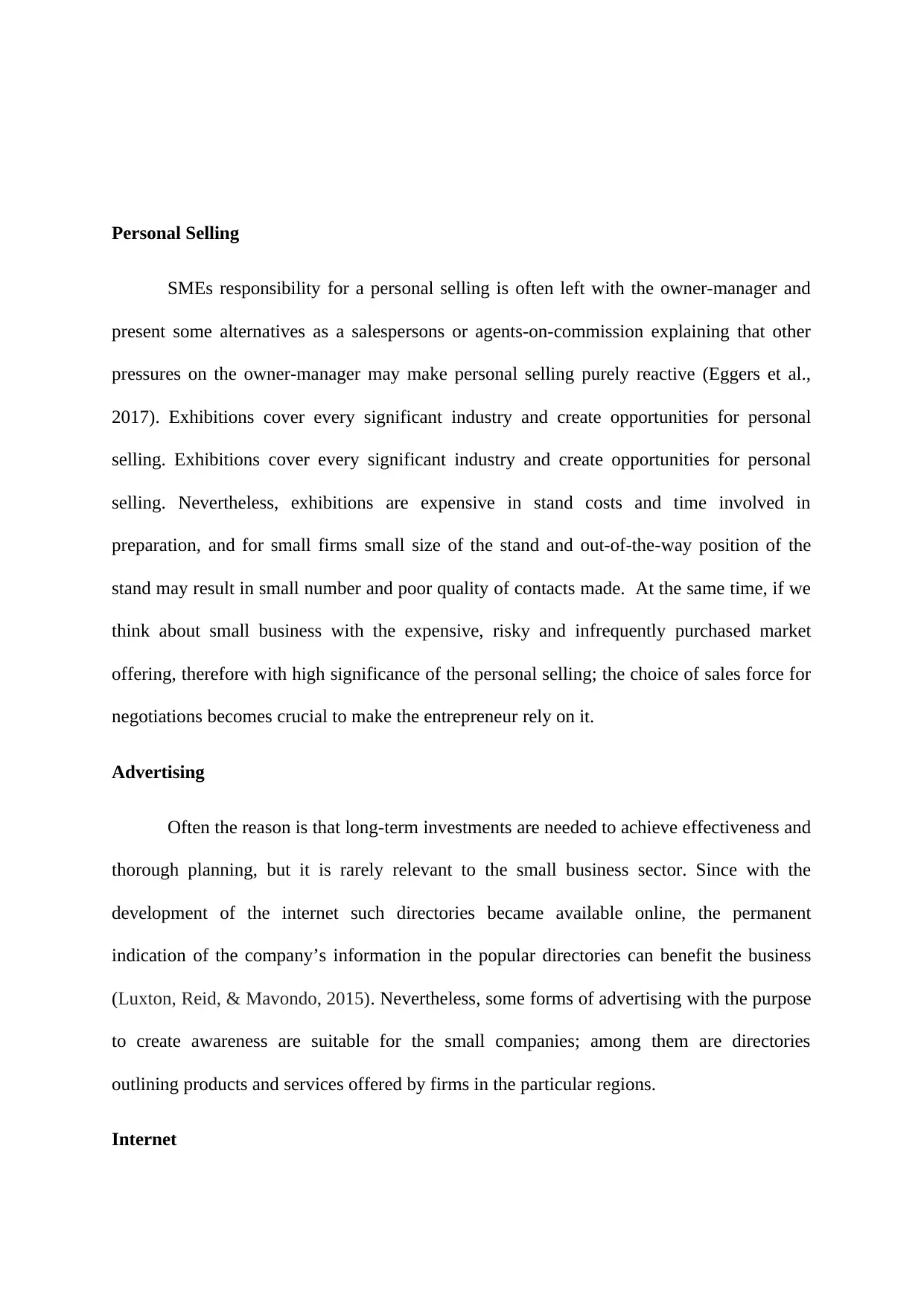
Personal Selling
SMEs responsibility for a personal selling is often left with the owner-manager and
present some alternatives as a salespersons or agents-on-commission explaining that other
pressures on the owner-manager may make personal selling purely reactive (Eggers et al.,
2017). Exhibitions cover every significant industry and create opportunities for personal
selling. Exhibitions cover every significant industry and create opportunities for personal
selling. Nevertheless, exhibitions are expensive in stand costs and time involved in
preparation, and for small firms small size of the stand and out-of-the-way position of the
stand may result in small number and poor quality of contacts made. At the same time, if we
think about small business with the expensive, risky and infrequently purchased market
offering, therefore with high significance of the personal selling; the choice of sales force for
negotiations becomes crucial to make the entrepreneur rely on it.
Advertising
Often the reason is that long-term investments are needed to achieve effectiveness and
thorough planning, but it is rarely relevant to the small business sector. Since with the
development of the internet such directories became available online, the permanent
indication of the company’s information in the popular directories can benefit the business
(Luxton, Reid, & Mavondo, 2015). Nevertheless, some forms of advertising with the purpose
to create awareness are suitable for the small companies; among them are directories
outlining products and services offered by firms in the particular regions.
Internet
SMEs responsibility for a personal selling is often left with the owner-manager and
present some alternatives as a salespersons or agents-on-commission explaining that other
pressures on the owner-manager may make personal selling purely reactive (Eggers et al.,
2017). Exhibitions cover every significant industry and create opportunities for personal
selling. Exhibitions cover every significant industry and create opportunities for personal
selling. Nevertheless, exhibitions are expensive in stand costs and time involved in
preparation, and for small firms small size of the stand and out-of-the-way position of the
stand may result in small number and poor quality of contacts made. At the same time, if we
think about small business with the expensive, risky and infrequently purchased market
offering, therefore with high significance of the personal selling; the choice of sales force for
negotiations becomes crucial to make the entrepreneur rely on it.
Advertising
Often the reason is that long-term investments are needed to achieve effectiveness and
thorough planning, but it is rarely relevant to the small business sector. Since with the
development of the internet such directories became available online, the permanent
indication of the company’s information in the popular directories can benefit the business
(Luxton, Reid, & Mavondo, 2015). Nevertheless, some forms of advertising with the purpose
to create awareness are suitable for the small companies; among them are directories
outlining products and services offered by firms in the particular regions.
Internet
⊘ This is a preview!⊘
Do you want full access?
Subscribe today to unlock all pages.

Trusted by 1+ million students worldwide
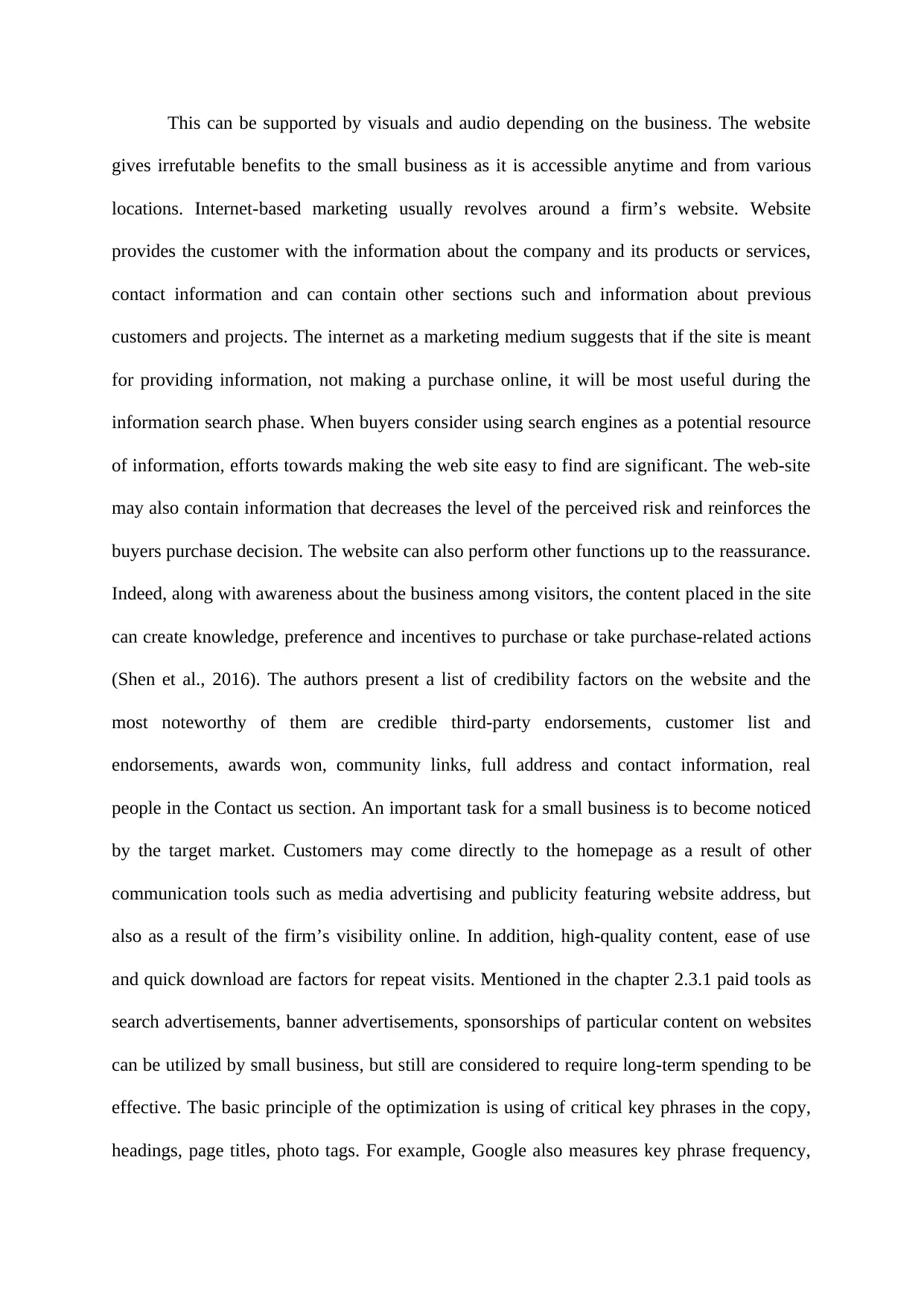
This can be supported by visuals and audio depending on the business. The website
gives irrefutable benefits to the small business as it is accessible anytime and from various
locations. Internet-based marketing usually revolves around a firm’s website. Website
provides the customer with the information about the company and its products or services,
contact information and can contain other sections such and information about previous
customers and projects. The internet as a marketing medium suggests that if the site is meant
for providing information, not making a purchase online, it will be most useful during the
information search phase. When buyers consider using search engines as a potential resource
of information, efforts towards making the web site easy to find are significant. The web-site
may also contain information that decreases the level of the perceived risk and reinforces the
buyers purchase decision. The website can also perform other functions up to the reassurance.
Indeed, along with awareness about the business among visitors, the content placed in the site
can create knowledge, preference and incentives to purchase or take purchase-related actions
(Shen et al., 2016). The authors present a list of credibility factors on the website and the
most noteworthy of them are credible third-party endorsements, customer list and
endorsements, awards won, community links, full address and contact information, real
people in the Contact us section. An important task for a small business is to become noticed
by the target market. Customers may come directly to the homepage as a result of other
communication tools such as media advertising and publicity featuring website address, but
also as a result of the firm’s visibility online. In addition, high-quality content, ease of use
and quick download are factors for repeat visits. Mentioned in the chapter 2.3.1 paid tools as
search advertisements, banner advertisements, sponsorships of particular content on websites
can be utilized by small business, but still are considered to require long-term spending to be
effective. The basic principle of the optimization is using of critical key phrases in the copy,
headings, page titles, photo tags. For example, Google also measures key phrase frequency,
gives irrefutable benefits to the small business as it is accessible anytime and from various
locations. Internet-based marketing usually revolves around a firm’s website. Website
provides the customer with the information about the company and its products or services,
contact information and can contain other sections such and information about previous
customers and projects. The internet as a marketing medium suggests that if the site is meant
for providing information, not making a purchase online, it will be most useful during the
information search phase. When buyers consider using search engines as a potential resource
of information, efforts towards making the web site easy to find are significant. The web-site
may also contain information that decreases the level of the perceived risk and reinforces the
buyers purchase decision. The website can also perform other functions up to the reassurance.
Indeed, along with awareness about the business among visitors, the content placed in the site
can create knowledge, preference and incentives to purchase or take purchase-related actions
(Shen et al., 2016). The authors present a list of credibility factors on the website and the
most noteworthy of them are credible third-party endorsements, customer list and
endorsements, awards won, community links, full address and contact information, real
people in the Contact us section. An important task for a small business is to become noticed
by the target market. Customers may come directly to the homepage as a result of other
communication tools such as media advertising and publicity featuring website address, but
also as a result of the firm’s visibility online. In addition, high-quality content, ease of use
and quick download are factors for repeat visits. Mentioned in the chapter 2.3.1 paid tools as
search advertisements, banner advertisements, sponsorships of particular content on websites
can be utilized by small business, but still are considered to require long-term spending to be
effective. The basic principle of the optimization is using of critical key phrases in the copy,
headings, page titles, photo tags. For example, Google also measures key phrase frequency,
Paraphrase This Document
Need a fresh take? Get an instant paraphrase of this document with our AI Paraphraser

regency of postings and inbound links from other sites (Ekka, 2016). There are many free and
paid tools available for search optimization, but it remains to be a difficult task for a marketer
and is out of the scope of this thesis. Each engine may use different criteria for listing the
results. Viral advertising is a modern method which combines word-of-mouth and digital
communications (Donnelly et al., 2015). It refers to utilizing the existing social networks’
ability to rapidly spread the message. If this opportunity is relevant to the company
interesting and amusing content containing marketing message can be placed in the social
networks which can be shared by users (Broekemier, Chau & Seshadri, 2015). The researcher
explains that some SMEs do not have the capability or time and they need a specialist or an
interested employee to keep the website competitive not to frustrate customers with poor e-
communications.
Intermediaries
Depending on the product the intermediaries can be, for example, agents and
distributors, wholesalers, or retail outlets. The use of intermediary usually refers to
distribution element of the marketing mix, it overlaps with communication one because it
affects how the information about the product or service reach the marketplace. Small firms
with limited resources can gain advantages by using intermediaries due to wider contacts,
specialization and scale of operations and knowledge especially when expanding to new
territories. In case an intermediary represents more than one supplier, the level of display and
promotional effort may vary (Fill & Turnbull, 2016). Nevertheless, using an intermediary
causes less control over how the product is presented and less influence over the marketing
effort.
Marketing Communication Planning
paid tools available for search optimization, but it remains to be a difficult task for a marketer
and is out of the scope of this thesis. Each engine may use different criteria for listing the
results. Viral advertising is a modern method which combines word-of-mouth and digital
communications (Donnelly et al., 2015). It refers to utilizing the existing social networks’
ability to rapidly spread the message. If this opportunity is relevant to the company
interesting and amusing content containing marketing message can be placed in the social
networks which can be shared by users (Broekemier, Chau & Seshadri, 2015). The researcher
explains that some SMEs do not have the capability or time and they need a specialist or an
interested employee to keep the website competitive not to frustrate customers with poor e-
communications.
Intermediaries
Depending on the product the intermediaries can be, for example, agents and
distributors, wholesalers, or retail outlets. The use of intermediary usually refers to
distribution element of the marketing mix, it overlaps with communication one because it
affects how the information about the product or service reach the marketplace. Small firms
with limited resources can gain advantages by using intermediaries due to wider contacts,
specialization and scale of operations and knowledge especially when expanding to new
territories. In case an intermediary represents more than one supplier, the level of display and
promotional effort may vary (Fill & Turnbull, 2016). Nevertheless, using an intermediary
causes less control over how the product is presented and less influence over the marketing
effort.
Marketing Communication Planning
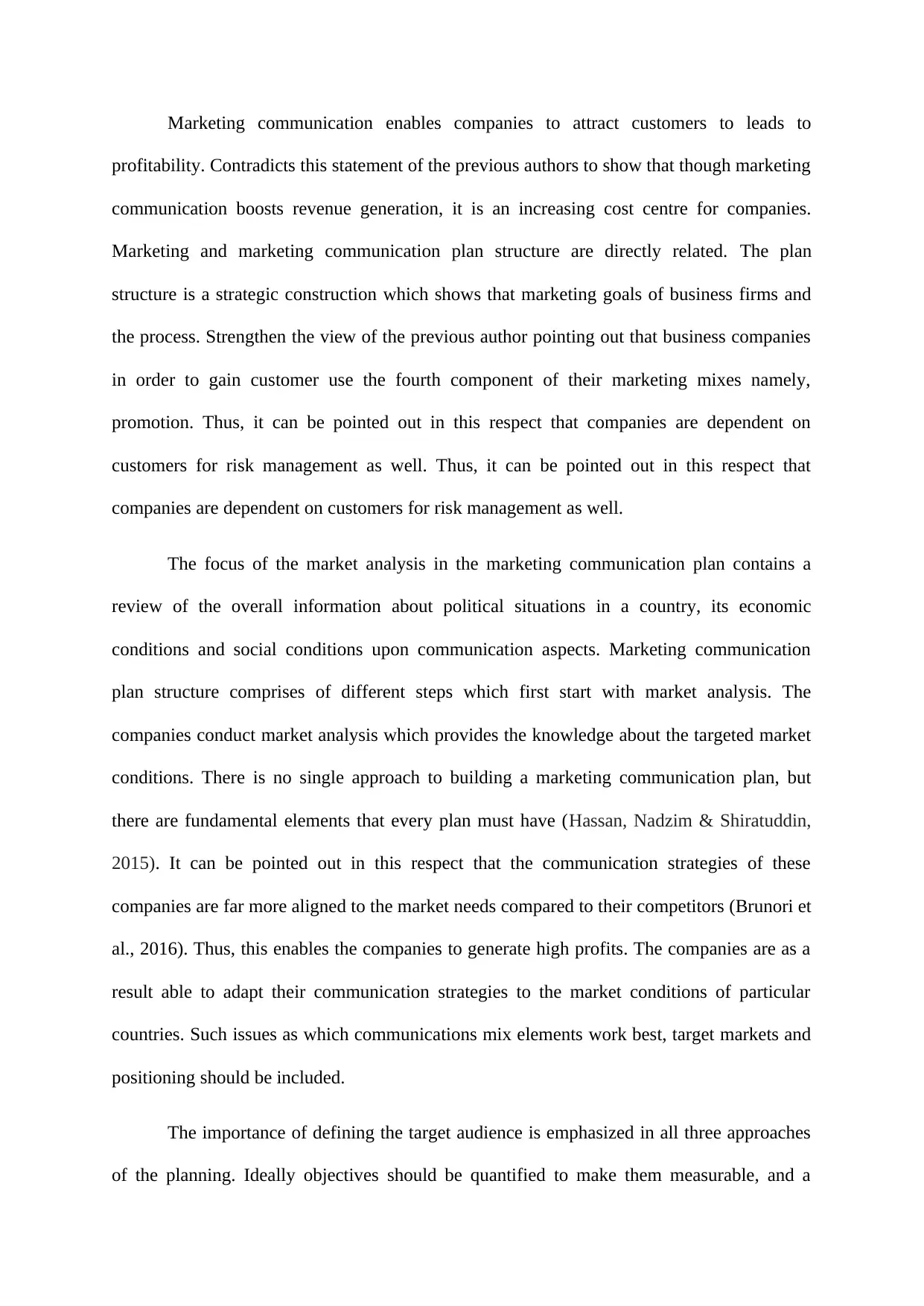
Marketing communication enables companies to attract customers to leads to
profitability. Contradicts this statement of the previous authors to show that though marketing
communication boosts revenue generation, it is an increasing cost centre for companies.
Marketing and marketing communication plan structure are directly related. The plan
structure is a strategic construction which shows that marketing goals of business firms and
the process. Strengthen the view of the previous author pointing out that business companies
in order to gain customer use the fourth component of their marketing mixes namely,
promotion. Thus, it can be pointed out in this respect that companies are dependent on
customers for risk management as well. Thus, it can be pointed out in this respect that
companies are dependent on customers for risk management as well.
The focus of the market analysis in the marketing communication plan contains a
review of the overall information about political situations in a country, its economic
conditions and social conditions upon communication aspects. Marketing communication
plan structure comprises of different steps which first start with market analysis. The
companies conduct market analysis which provides the knowledge about the targeted market
conditions. There is no single approach to building a marketing communication plan, but
there are fundamental elements that every plan must have (Hassan, Nadzim & Shiratuddin,
2015). It can be pointed out in this respect that the communication strategies of these
companies are far more aligned to the market needs compared to their competitors (Brunori et
al., 2016). Thus, this enables the companies to generate high profits. The companies are as a
result able to adapt their communication strategies to the market conditions of particular
countries. Such issues as which communications mix elements work best, target markets and
positioning should be included.
The importance of defining the target audience is emphasized in all three approaches
of the planning. Ideally objectives should be quantified to make them measurable, and a
profitability. Contradicts this statement of the previous authors to show that though marketing
communication boosts revenue generation, it is an increasing cost centre for companies.
Marketing and marketing communication plan structure are directly related. The plan
structure is a strategic construction which shows that marketing goals of business firms and
the process. Strengthen the view of the previous author pointing out that business companies
in order to gain customer use the fourth component of their marketing mixes namely,
promotion. Thus, it can be pointed out in this respect that companies are dependent on
customers for risk management as well. Thus, it can be pointed out in this respect that
companies are dependent on customers for risk management as well.
The focus of the market analysis in the marketing communication plan contains a
review of the overall information about political situations in a country, its economic
conditions and social conditions upon communication aspects. Marketing communication
plan structure comprises of different steps which first start with market analysis. The
companies conduct market analysis which provides the knowledge about the targeted market
conditions. There is no single approach to building a marketing communication plan, but
there are fundamental elements that every plan must have (Hassan, Nadzim & Shiratuddin,
2015). It can be pointed out in this respect that the communication strategies of these
companies are far more aligned to the market needs compared to their competitors (Brunori et
al., 2016). Thus, this enables the companies to generate high profits. The companies are as a
result able to adapt their communication strategies to the market conditions of particular
countries. Such issues as which communications mix elements work best, target markets and
positioning should be included.
The importance of defining the target audience is emphasized in all three approaches
of the planning. Ideally objectives should be quantified to make them measurable, and a
⊘ This is a preview!⊘
Do you want full access?
Subscribe today to unlock all pages.

Trusted by 1+ million students worldwide

timescale should be specified. Communication structure then goes on to the second step,
identifying the customer segments to which they are likely to sell their products. The target
audience has a significant impact of the communications planning since it determines what to
say, how, when, where and to whom. Not all communication objectives should be present in
the plan as they are determined depending on the situation. This is followed by a third step,
setting of communication goals which the company wants to achieve. Communication
objectives usually concern sales, market share, and creating new products.
Small companies may apply bottom-up marketing which give a possibility to find
unique tactics and develop it into a strategy. The fourth step consists of formation of
strategies which the companies use to achieve their goals. This is because with the emergence
of omni-channel marketing companies spend immense amount of money in marketing
communication (Jones, Borgman & Ulusoy 2015). Overall direction for achieving the set
communication objectives may describe target groups of communications activities, the
desired effect on the defined groups, tool used for communications, the integration of the
communication activities. Designing communications and set three tasks which should be
completed: decide what to say.
As to the buyer readiness, advertising and publicity are significant in the cognitive
stage, in the affective stage the importance of personal selling increases, behavioural stage
and reorder are mostly affected by personal selling and promotions. For example, particular
tools’ importance varies between consumer and business markets. The authors tell that in
consumer markets sales promotions and advertising are utilized comparatively more; and a
business marketer tend to spend more on personal selling. Factors affecting the selection of a
communication mix when creating a marketing communication strategy are type of market
offering, customer’s readiness to make a purchase, and stage in the product life cycle.
Product life cycle affects in the following way: advertising and publicity are important during
identifying the customer segments to which they are likely to sell their products. The target
audience has a significant impact of the communications planning since it determines what to
say, how, when, where and to whom. Not all communication objectives should be present in
the plan as they are determined depending on the situation. This is followed by a third step,
setting of communication goals which the company wants to achieve. Communication
objectives usually concern sales, market share, and creating new products.
Small companies may apply bottom-up marketing which give a possibility to find
unique tactics and develop it into a strategy. The fourth step consists of formation of
strategies which the companies use to achieve their goals. This is because with the emergence
of omni-channel marketing companies spend immense amount of money in marketing
communication (Jones, Borgman & Ulusoy 2015). Overall direction for achieving the set
communication objectives may describe target groups of communications activities, the
desired effect on the defined groups, tool used for communications, the integration of the
communication activities. Designing communications and set three tasks which should be
completed: decide what to say.
As to the buyer readiness, advertising and publicity are significant in the cognitive
stage, in the affective stage the importance of personal selling increases, behavioural stage
and reorder are mostly affected by personal selling and promotions. For example, particular
tools’ importance varies between consumer and business markets. The authors tell that in
consumer markets sales promotions and advertising are utilized comparatively more; and a
business marketer tend to spend more on personal selling. Factors affecting the selection of a
communication mix when creating a marketing communication strategy are type of market
offering, customer’s readiness to make a purchase, and stage in the product life cycle.
Product life cycle affects in the following way: advertising and publicity are important during
Paraphrase This Document
Need a fresh take? Get an instant paraphrase of this document with our AI Paraphraser
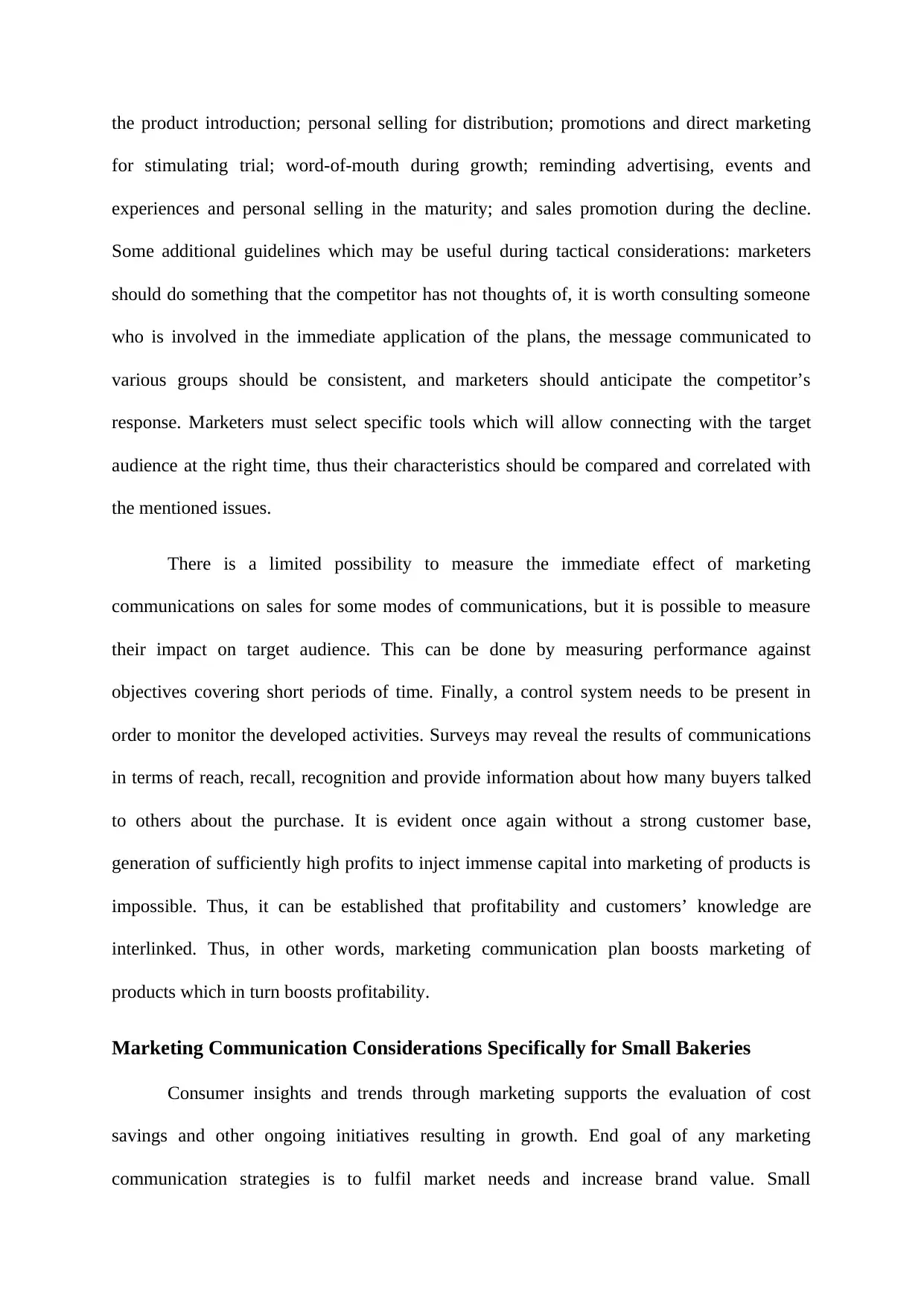
the product introduction; personal selling for distribution; promotions and direct marketing
for stimulating trial; word-of-mouth during growth; reminding advertising, events and
experiences and personal selling in the maturity; and sales promotion during the decline.
Some additional guidelines which may be useful during tactical considerations: marketers
should do something that the competitor has not thoughts of, it is worth consulting someone
who is involved in the immediate application of the plans, the message communicated to
various groups should be consistent, and marketers should anticipate the competitor’s
response. Marketers must select specific tools which will allow connecting with the target
audience at the right time, thus their characteristics should be compared and correlated with
the mentioned issues.
There is a limited possibility to measure the immediate effect of marketing
communications on sales for some modes of communications, but it is possible to measure
their impact on target audience. This can be done by measuring performance against
objectives covering short periods of time. Finally, a control system needs to be present in
order to monitor the developed activities. Surveys may reveal the results of communications
in terms of reach, recall, recognition and provide information about how many buyers talked
to others about the purchase. It is evident once again without a strong customer base,
generation of sufficiently high profits to inject immense capital into marketing of products is
impossible. Thus, it can be established that profitability and customers’ knowledge are
interlinked. Thus, in other words, marketing communication plan boosts marketing of
products which in turn boosts profitability.
Marketing Communication Considerations Specifically for Small Bakeries
Consumer insights and trends through marketing supports the evaluation of cost
savings and other ongoing initiatives resulting in growth. End goal of any marketing
communication strategies is to fulfil market needs and increase brand value. Small
for stimulating trial; word-of-mouth during growth; reminding advertising, events and
experiences and personal selling in the maturity; and sales promotion during the decline.
Some additional guidelines which may be useful during tactical considerations: marketers
should do something that the competitor has not thoughts of, it is worth consulting someone
who is involved in the immediate application of the plans, the message communicated to
various groups should be consistent, and marketers should anticipate the competitor’s
response. Marketers must select specific tools which will allow connecting with the target
audience at the right time, thus their characteristics should be compared and correlated with
the mentioned issues.
There is a limited possibility to measure the immediate effect of marketing
communications on sales for some modes of communications, but it is possible to measure
their impact on target audience. This can be done by measuring performance against
objectives covering short periods of time. Finally, a control system needs to be present in
order to monitor the developed activities. Surveys may reveal the results of communications
in terms of reach, recall, recognition and provide information about how many buyers talked
to others about the purchase. It is evident once again without a strong customer base,
generation of sufficiently high profits to inject immense capital into marketing of products is
impossible. Thus, it can be established that profitability and customers’ knowledge are
interlinked. Thus, in other words, marketing communication plan boosts marketing of
products which in turn boosts profitability.
Marketing Communication Considerations Specifically for Small Bakeries
Consumer insights and trends through marketing supports the evaluation of cost
savings and other ongoing initiatives resulting in growth. End goal of any marketing
communication strategies is to fulfil market needs and increase brand value. Small

businesses, including small, independent bakeries must develop strategic approaches to assist
in achieving growth opportunities and gather insights regarding marketing activities to
forecast growth and sustainability patterns.
Implementing a coordinated marketing communication plan for new and existing
products and services can also help small, independent entrepreneurs make improvements or
modifications based on adjustments in the competitive landscape (Wang, Pauleen & Zhang,
2016). New products keeps customers aware of new offerings, yet in the long run small
organizations must involve insights from customers to generate appropriate promotion,
advertising, fundraising, and public relations acting as principles of marketing
communication strategy.
Thirty-four percent of small bakery owners do not examine the effects of their
marketing communication activity or follow up with existing customers to confirm their
needs, establish and maintain positive relationships with existing and potential customers.
Unlike large organizations, marketing communication strategies and activities for small
businesses are distinctively different. Data gathered from the SWOT analysis can be
afterwards used for adjustments and implementations of a strategic marketing communication
plan for profitability. Through the analysis of a strategic marketing plan, small business
owners can obtain information on the SWOT against the competitors’ and other elements
such as previous sales and profitability per consumer.
in achieving growth opportunities and gather insights regarding marketing activities to
forecast growth and sustainability patterns.
Implementing a coordinated marketing communication plan for new and existing
products and services can also help small, independent entrepreneurs make improvements or
modifications based on adjustments in the competitive landscape (Wang, Pauleen & Zhang,
2016). New products keeps customers aware of new offerings, yet in the long run small
organizations must involve insights from customers to generate appropriate promotion,
advertising, fundraising, and public relations acting as principles of marketing
communication strategy.
Thirty-four percent of small bakery owners do not examine the effects of their
marketing communication activity or follow up with existing customers to confirm their
needs, establish and maintain positive relationships with existing and potential customers.
Unlike large organizations, marketing communication strategies and activities for small
businesses are distinctively different. Data gathered from the SWOT analysis can be
afterwards used for adjustments and implementations of a strategic marketing communication
plan for profitability. Through the analysis of a strategic marketing plan, small business
owners can obtain information on the SWOT against the competitors’ and other elements
such as previous sales and profitability per consumer.
⊘ This is a preview!⊘
Do you want full access?
Subscribe today to unlock all pages.

Trusted by 1+ million students worldwide
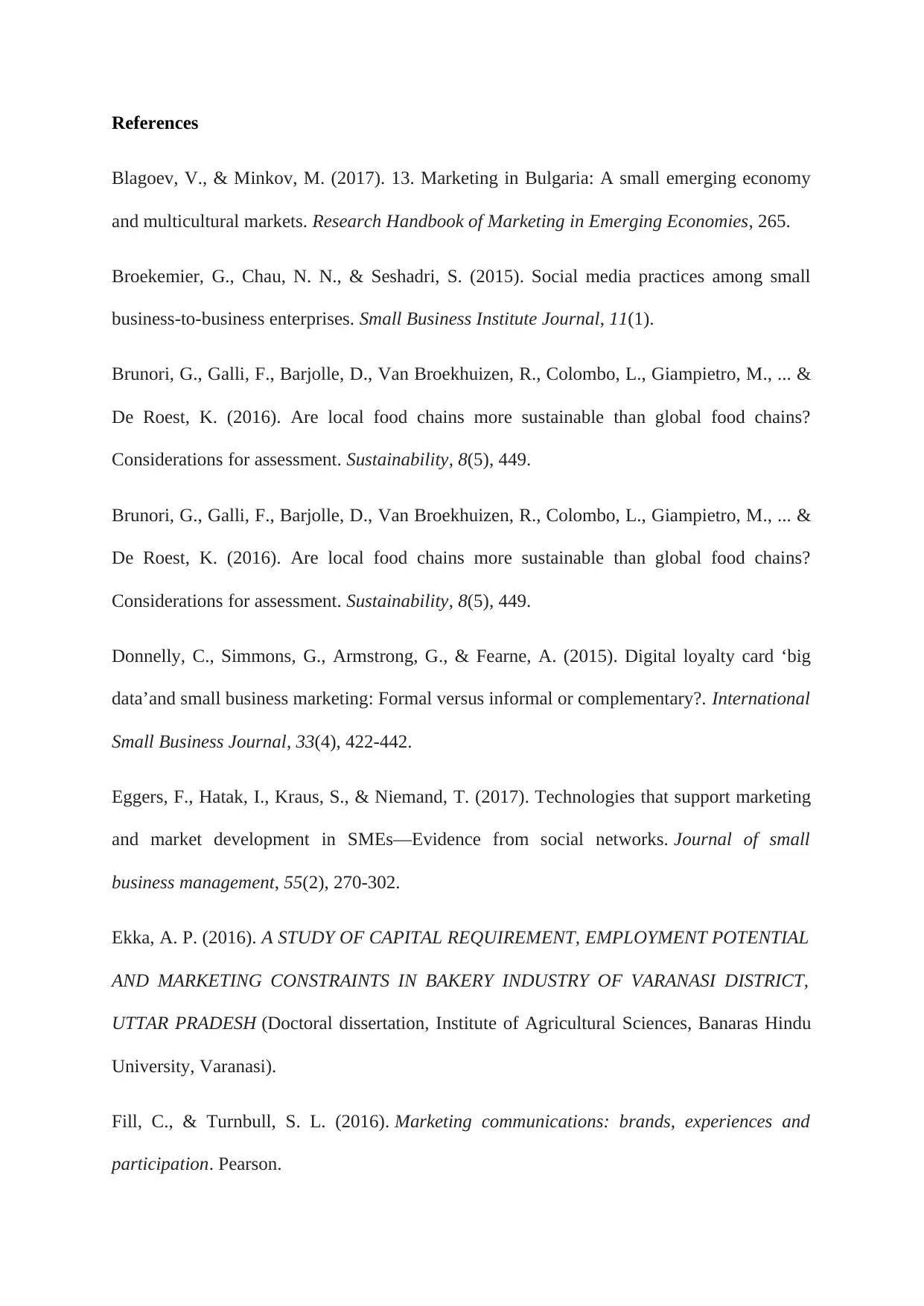
References
Blagoev, V., & Minkov, M. (2017). 13. Marketing in Bulgaria: A small emerging economy
and multicultural markets. Research Handbook of Marketing in Emerging Economies, 265.
Broekemier, G., Chau, N. N., & Seshadri, S. (2015). Social media practices among small
business-to-business enterprises. Small Business Institute Journal, 11(1).
Brunori, G., Galli, F., Barjolle, D., Van Broekhuizen, R., Colombo, L., Giampietro, M., ... &
De Roest, K. (2016). Are local food chains more sustainable than global food chains?
Considerations for assessment. Sustainability, 8(5), 449.
Brunori, G., Galli, F., Barjolle, D., Van Broekhuizen, R., Colombo, L., Giampietro, M., ... &
De Roest, K. (2016). Are local food chains more sustainable than global food chains?
Considerations for assessment. Sustainability, 8(5), 449.
Donnelly, C., Simmons, G., Armstrong, G., & Fearne, A. (2015). Digital loyalty card ‘big
data’and small business marketing: Formal versus informal or complementary?. International
Small Business Journal, 33(4), 422-442.
Eggers, F., Hatak, I., Kraus, S., & Niemand, T. (2017). Technologies that support marketing
and market development in SMEs—Evidence from social networks. Journal of small
business management, 55(2), 270-302.
Ekka, A. P. (2016). A STUDY OF CAPITAL REQUIREMENT, EMPLOYMENT POTENTIAL
AND MARKETING CONSTRAINTS IN BAKERY INDUSTRY OF VARANASI DISTRICT,
UTTAR PRADESH (Doctoral dissertation, Institute of Agricultural Sciences, Banaras Hindu
University, Varanasi).
Fill, C., & Turnbull, S. L. (2016). Marketing communications: brands, experiences and
participation. Pearson.
Blagoev, V., & Minkov, M. (2017). 13. Marketing in Bulgaria: A small emerging economy
and multicultural markets. Research Handbook of Marketing in Emerging Economies, 265.
Broekemier, G., Chau, N. N., & Seshadri, S. (2015). Social media practices among small
business-to-business enterprises. Small Business Institute Journal, 11(1).
Brunori, G., Galli, F., Barjolle, D., Van Broekhuizen, R., Colombo, L., Giampietro, M., ... &
De Roest, K. (2016). Are local food chains more sustainable than global food chains?
Considerations for assessment. Sustainability, 8(5), 449.
Brunori, G., Galli, F., Barjolle, D., Van Broekhuizen, R., Colombo, L., Giampietro, M., ... &
De Roest, K. (2016). Are local food chains more sustainable than global food chains?
Considerations for assessment. Sustainability, 8(5), 449.
Donnelly, C., Simmons, G., Armstrong, G., & Fearne, A. (2015). Digital loyalty card ‘big
data’and small business marketing: Formal versus informal or complementary?. International
Small Business Journal, 33(4), 422-442.
Eggers, F., Hatak, I., Kraus, S., & Niemand, T. (2017). Technologies that support marketing
and market development in SMEs—Evidence from social networks. Journal of small
business management, 55(2), 270-302.
Ekka, A. P. (2016). A STUDY OF CAPITAL REQUIREMENT, EMPLOYMENT POTENTIAL
AND MARKETING CONSTRAINTS IN BAKERY INDUSTRY OF VARANASI DISTRICT,
UTTAR PRADESH (Doctoral dissertation, Institute of Agricultural Sciences, Banaras Hindu
University, Varanasi).
Fill, C., & Turnbull, S. L. (2016). Marketing communications: brands, experiences and
participation. Pearson.
Paraphrase This Document
Need a fresh take? Get an instant paraphrase of this document with our AI Paraphraser
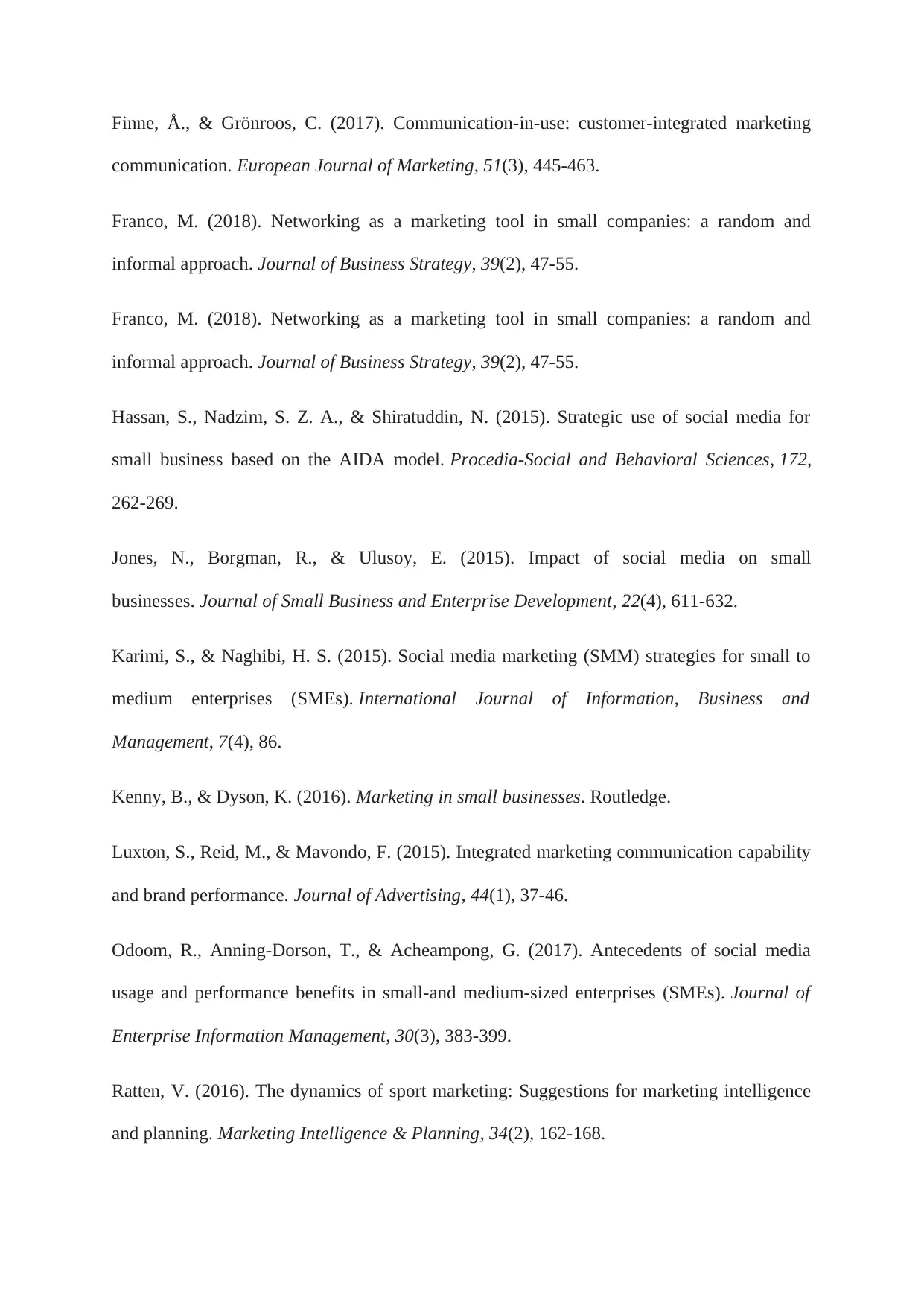
Finne, Å., & Grönroos, C. (2017). Communication-in-use: customer-integrated marketing
communication. European Journal of Marketing, 51(3), 445-463.
Franco, M. (2018). Networking as a marketing tool in small companies: a random and
informal approach. Journal of Business Strategy, 39(2), 47-55.
Franco, M. (2018). Networking as a marketing tool in small companies: a random and
informal approach. Journal of Business Strategy, 39(2), 47-55.
Hassan, S., Nadzim, S. Z. A., & Shiratuddin, N. (2015). Strategic use of social media for
small business based on the AIDA model. Procedia-Social and Behavioral Sciences, 172,
262-269.
Jones, N., Borgman, R., & Ulusoy, E. (2015). Impact of social media on small
businesses. Journal of Small Business and Enterprise Development, 22(4), 611-632.
Karimi, S., & Naghibi, H. S. (2015). Social media marketing (SMM) strategies for small to
medium enterprises (SMEs). International Journal of Information, Business and
Management, 7(4), 86.
Kenny, B., & Dyson, K. (2016). Marketing in small businesses. Routledge.
Luxton, S., Reid, M., & Mavondo, F. (2015). Integrated marketing communication capability
and brand performance. Journal of Advertising, 44(1), 37-46.
Odoom, R., Anning-Dorson, T., & Acheampong, G. (2017). Antecedents of social media
usage and performance benefits in small-and medium-sized enterprises (SMEs). Journal of
Enterprise Information Management, 30(3), 383-399.
Ratten, V. (2016). The dynamics of sport marketing: Suggestions for marketing intelligence
and planning. Marketing Intelligence & Planning, 34(2), 162-168.
communication. European Journal of Marketing, 51(3), 445-463.
Franco, M. (2018). Networking as a marketing tool in small companies: a random and
informal approach. Journal of Business Strategy, 39(2), 47-55.
Franco, M. (2018). Networking as a marketing tool in small companies: a random and
informal approach. Journal of Business Strategy, 39(2), 47-55.
Hassan, S., Nadzim, S. Z. A., & Shiratuddin, N. (2015). Strategic use of social media for
small business based on the AIDA model. Procedia-Social and Behavioral Sciences, 172,
262-269.
Jones, N., Borgman, R., & Ulusoy, E. (2015). Impact of social media on small
businesses. Journal of Small Business and Enterprise Development, 22(4), 611-632.
Karimi, S., & Naghibi, H. S. (2015). Social media marketing (SMM) strategies for small to
medium enterprises (SMEs). International Journal of Information, Business and
Management, 7(4), 86.
Kenny, B., & Dyson, K. (2016). Marketing in small businesses. Routledge.
Luxton, S., Reid, M., & Mavondo, F. (2015). Integrated marketing communication capability
and brand performance. Journal of Advertising, 44(1), 37-46.
Odoom, R., Anning-Dorson, T., & Acheampong, G. (2017). Antecedents of social media
usage and performance benefits in small-and medium-sized enterprises (SMEs). Journal of
Enterprise Information Management, 30(3), 383-399.
Ratten, V. (2016). The dynamics of sport marketing: Suggestions for marketing intelligence
and planning. Marketing Intelligence & Planning, 34(2), 162-168.

Shen, G. C. C., Chiou, J. S., Hsiao, C. H., Wang, C. H., & Li, H. N. (2016). Effective
marketing communication via social networking site: The moderating role of the social
tie. Journal of Business Research, 69(6), 2265-2270.
Wang, W. Y., Pauleen, D. J., & Zhang, T. (2016). How social media applications affect B2B
communication and improve business performance in SMEs. Industrial Marketing
Management, 54, 4-14.
marketing communication via social networking site: The moderating role of the social
tie. Journal of Business Research, 69(6), 2265-2270.
Wang, W. Y., Pauleen, D. J., & Zhang, T. (2016). How social media applications affect B2B
communication and improve business performance in SMEs. Industrial Marketing
Management, 54, 4-14.
⊘ This is a preview!⊘
Do you want full access?
Subscribe today to unlock all pages.

Trusted by 1+ million students worldwide
1 out of 12
Related Documents
Your All-in-One AI-Powered Toolkit for Academic Success.
+13062052269
info@desklib.com
Available 24*7 on WhatsApp / Email
![[object Object]](/_next/static/media/star-bottom.7253800d.svg)
Unlock your academic potential
Copyright © 2020–2025 A2Z Services. All Rights Reserved. Developed and managed by ZUCOL.




